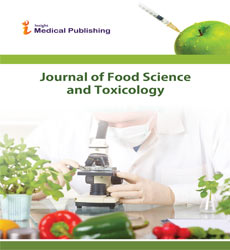Aflatoxins Prevalence and Contamination level in Household foodstuff in Southwestern Uganda: Association to Hepatocellular cancer and chronic malnutrition
Abstract
Ingestion of aflatoxin contaminated household foodstuffs has been associated with recent increase in Hepato Cellular Cancers (HCC) and chronic malnutrition cases in Southwestern Uganda. Aflatoxins are toxins produced by molds especially of species Aspergillus flavus, and Aspergillus parasiticus. In this study, aflatoxin prevalence, contamination levels in commonly consumed household foodstuff and their consumption frequency determined; an association was made between aflatoxin contamination levels, household food consumption frequency and observed incidence of hepatocellular cancer as well as chronic malnutrition in the study area. Flours of commonly consume household foodstuff (groundnuts, maize, millet and sorghum) were randomly sampled from seven districts in S.W. Uganda and analyzed for presence and contamination levels of aflatoxin using competitive ELISA. Groundnut samples had the highest mean aflatoxin contamination level (96.5 ± 13.7 µg/kg), range 6.2 to 297.3 µg/kg. More than 90% of the groundnut samples had aflatoxin levels above 10 µg/kg, the East African regulatory limit. Maize flour was second with a mean aflatoxin level of 34.1 ± 14 µg/kg, with one sample registering aflatoxin level as high as 336.5 µg/kg. Millet flour was third, with mean aflatoxin level 11.7 ± 4.2 µg/kg, ranging from undectectable level to 46.5 µg/kg. Half of the millet samples were contaminated by aflatoxins, with 43% having contamination levels above 10 µg/kg the East African regulatory limit. Sorghum samples have the least aflatoxins contamination levels of (12 ± 2.8 µg/kg), ranging from undetectable levels to 25.5 µg/kg. About 67% of the sorghum samples were contaminated by aflatoxins, with 58.3% having levels above 10 µg/kg the East African regulatory limit. Off all the districts in the region, household foodstuff from Kasese district had the highest levels of aflatoxins contamination 211.27 ± 13.7 µg/kg and 88.1 ± 50.3 µg/kg respectively for groundnuts and maize. The most contaminated millet samples were from Rubanda district (33.3 µg/kg) and Kasese district (26.1 ± 13.7 µg/kg). The aflatoxin levels in sorghum were highest in Bushenyi district (18.3 ± 7.2 µg/kg) and Rukiga district (17.4 µg/kg). This study re-affirms previous data about the high aflatoxin prevalence and contamination of commonly consumed household foodstuff in S.W. Uganda thus, underlining the health risk and dangers to the population of HCC and effects of chronic malnutrition from latent aflatoxin exposure from contaminated household foods. The study recommends increased awareness on aflatoxins and further investigation to establish clinical markers of hepatocellular cancer and chronic malnutriton cases arising from aflatoxins exposure in household foods.
Keywords: Aflatoxins prevalence; Contamination levels; Household food consumption frequency; Hepatocellular cancer and Chronic malnutrition; Southwest Uganda
Open Access Journals
- Aquaculture & Veterinary Science
- Chemistry & Chemical Sciences
- Clinical Sciences
- Engineering
- General Science
- Genetics & Molecular Biology
- Health Care & Nursing
- Immunology & Microbiology
- Materials Science
- Mathematics & Physics
- Medical Sciences
- Neurology & Psychiatry
- Oncology & Cancer Science
- Pharmaceutical Sciences
